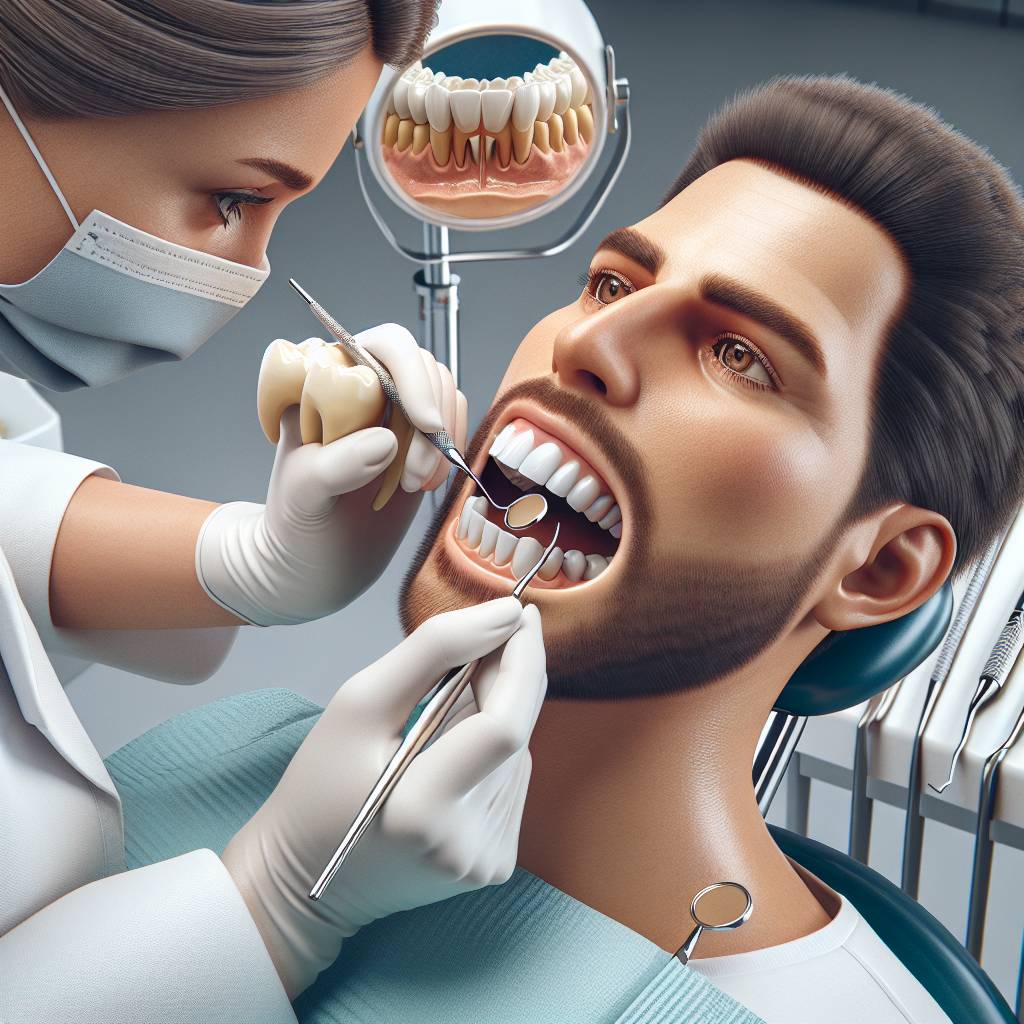Crowns are a common dental procedure used to restore damaged teeth. Crowns can also be used to improve the appearance of a tooth. If you have a front tooth that is cracked, decayed, or otherwise damaged, your dentist may recommend installing a crown on it. This article will discuss how crowns are placed on front teeth and the benefits of having them installed.Dentists put crowns on front teeth by first removing any decay or damaged portions of the tooth. They then shape the tooth to make room for the crown. An impression is taken of the prepared tooth and a temporary crown is placed over it. The impression is sent to a lab where a custom-made permanent crown is created and sent back to the dentist. The dentist then cements the permanent crown onto the prepared tooth, making sure that it fits properly and looks natural.
Preparation for Front Tooth Crown Procedure
The preparation process for a front tooth crown procedure typically involves a few steps. First, your dentist will need to assess the health and condition of the tooth that needs a crown. X-rays and other imaging tests may be used to assess the extent of tooth damage. The dentist may also need to remove any decay or infection before placing a crown. If there is extensive damage, the dentist may need to place a post in the tooth and build up the structure with special materials.
The next step in preparation for a front tooth crown is shaping the existing tooth structure. This involves removing any excess structure so that the crown can fit comfortably and securely on top of it. Your dentist will also need to make sure that there is adequate space between adjacent teeth for proper placement of the crown.
The final step in preparation for a front tooth crown is taking an impression of your teeth. This involves pressing putty into your mouth and leaving it there until it hardens so that an exact model can be made from it. This will serve as a template for making your custom-fitted crown. Once this step is complete, your dentist may schedule another appointment to fit and place your new crown or send your model off to an external lab where they will make it according to specifications given by your dentist.
It is important to follow all instructions given by your dentist during this process in order to ensure successful placement of the front tooth crown. Following these steps should help you prepare properly for this dental procedure so you can get back smiling confidently with a brand new smile!
Appearance
Front tooth crowns can improve the appearance of your teeth, making them look more natural and aesthetic. For instance, they can cover up any cracks or chips, as well as discoloration. They are also a great option for restoring a missing tooth, as they provide a natural-looking replacement. Additionally, front tooth crowns are designed to blend in with your natural teeth, giving you a beautiful smile.
Durability
Front tooth crowns are incredibly durable and can last for many years with proper care and maintenance. In fact, they often have a lifespan of 10 years or more when cared for properly. Additionally, these crowns are made from strong materials such as porcelain or metal that can withstand everyday wear and tear. With this added durability, you won’t have to worry about your front tooth crown becoming damaged over time.
Protection
In addition to being aesthetically pleasing and durable, front tooth crowns offer protection for your teeth. This is especially important if your teeth have been weakened or damaged due to decay or injury. The crown acts like an extra layer of protection by preventing further damage from occurring to the underlying tooth structure. Additionally, it also helps protect against further decay by creating an effective barrier against bacteria that can cause cavities.
Cost-Effective
Another advantage of front tooth crowns is that they are generally cost-effective when compared to other restoration treatments such as dental implants. Since these crowns last for many years with proper care and maintenance, you won’t have to worry about frequent visits to the dentist or costly repairs. Additionally, many insurance companies cover at least part of the cost of these procedures which can help make them even more affordable.
Types of Materials Used for Front Tooth Crowns
There are several different types of materials used to make front tooth crowns. The most common materials used are metal, ceramic, and composite resin. Each type of material has its own advantages and disadvantages that should be taken into consideration when deciding which type of crown is right for you.
Metal Crowns
Metal crowns are the strongest and most durable type of crown available. They can withstand the most wear and tear, making them ideal for molars and other back teeth that take the brunt of your bite force. Metal crowns are also less likely to break or chip than other materials. The downside to metal crowns is that they can be more difficult to match with the natural color of your teeth, so they may be more visible when you smile.
Ceramic Crowns
Ceramic crowns have a more natural appearance than metal ones and blend in well with your other teeth. They’re also resistant to staining, making them a good choice if you want your front teeth to look their best for a long time. Ceramic crowns are generally durable, but they may not withstand as much wear and tear as metal ones do, so they’re best used on front teeth where their natural appearance is a priority.
Composite Resin Crowns
Composite resin crowns are made from a mixture of plastic and ceramic particles that can be molded into shape and colored to match your existing teeth. They’re less expensive than other types of crowns but may not last as long due to their softer material composition. Composite resin crowns may also require more frequent visits for adjustments or repairs than other types of materials do.
Overall, the best material for your front tooth crown will depend on your individual needs and preferences. Talk to your dentist about what kind of material would work best for you before deciding on a type of front tooth crown.
Cost of Front Tooth Crowns
Front tooth crowns are an important part of dental care and can help to improve the appearance and strength of the teeth. A crown can be used to restore a tooth that has been damaged due to trauma or decay, and can also be used to improve the appearance of a tooth that is discolored or misshapen. The cost of a front tooth crown will vary depending on the type of material used and other factors such as the dentist’s experience, location, and insurance coverage.
The most common type of material used for front tooth crowns is porcelain, which is available in various shades to match existing teeth. Porcelain crowns are highly durable and are less likely to chip or break than other materials. They are also more expensive than other types of materials such as metal alloys, so they tend to be more costly upfront.
Other materials that may be used for front tooth crowns include gold, silver, or composite resin. Gold and silver crowns provide superior strength compared to porcelain but may be more expensive due to their precious metal content. Composite resin is a cheaper option but is prone to staining over time.
The cost of a front tooth crown will also depend on the experience level of the dentist who performs the procedure. Experienced dentists may charge more for their services as their skillset is more extensive than less experienced dentists. Additionally, geographic location can also affect pricing; dentists in urban areas may charge higher prices than those in rural areas due to higher overhead costs associated with running a practice in an urban setting.
Finally, insurance coverage can play an important factor when considering the cost of a front tooth crown. Most insurance companies will cover at least part of the cost if it is deemed necessary by your dentist; however, some policies may not cover any portion of the procedure at all so it’s important to check with your provider before scheduling an appointment with your dentist.
In conclusion, there are many factors that can affect the cost of front tooth crowns including type of material used, geographic location, experience level of your dentist, and insurance coverage. In order to determine how much you will need to pay for this procedure it’s best to consult with your dentist about what options are available and get an estimate based on your individual needs and circumstances.

Care and Maintenance After Getting a Front Tooth Crown
It is important to take proper care and maintenance of your front tooth crown after it has been placed. Proper care and maintenance can help ensure that your crown lasts for many years. Here are some tips for taking care of your new front tooth crown:
Brush and Floss Regularly
Brushing and flossing regularly are essential for good oral hygiene, even with a crown. Make sure to brush twice daily with fluoride toothpaste, paying special attention to the area around the crown. Flossing at least once per day will help remove any food particles that may be stuck in the area between the crown and the adjacent teeth.
See Your Dentist Regularly
Regular dental visits are important for maintaining good oral health, even when you have a front tooth crown. During your regular check-ups, your dentist will check to make sure that your crown is still in place and not causing any damage to other teeth or gums.
Avoid Chewing Hard Food or Objects
Chewing hard food or objects can cause damage to your front tooth crown, as well as other teeth in the area. Avoid chewing on ice cubes, pencils, or other hard objects that could cause damage to your dental work.
Avoid Biting on Your Crown
It is easy to forget that you have a new dental work when it is placed in the front of your mouth. However, it is important to remember not to bite down on your front tooth crown as this can cause it to crack or break.
By following these simple tips for taking care of your front tooth crown, you can ensure that it lasts for many years and remains in good condition.
Complications That May Arise After Getting a Front Tooth Crown
After getting a front tooth crown, there are a few potential complications that may arise. One of the most common issues is sensitivity in the gums surrounding the crown. This may be caused by any rough edges left after the crown was placed or due to the materials used in the crown itself. If your gums become too sensitive, it’s important to contact your dentist as soon as possible to get it adjusted.
Another complication that can happen after getting a front tooth crown is discoloration. This can occur if your dentist uses porcelain or composite material for your crown and it doesn’t match your other teeth perfectly. If you notice this, you should be able to have it replaced with another one that more closely matches your other teeth in color and shape.
The third possible complication that may arise after getting a front tooth crown is infection. This can happen if bacteria gets into the area around the crown and causes an infection in the gums or jawbone. If this occurs, you may need antibiotics or even surgery to treat it properly.
Finally, there could be an issue with the fit of your crown if it’s not properly fitted by your dentist. This could cause pain when chewing or talking, and it can also cause food particles to get stuck between your teeth and gums, leading to further discomfort and infection risks. If you experience any of these issues, make sure you contact your dentist right away for help in resolving them.
How Long Does A Front Tooth Crown Last?
A front tooth crown typically has an estimated lifespan of 5-15 years, depending on how well it is cared for. Proper oral hygiene practices, such as brushing and flossing, are essential for keeping the crown and the tooth beneath it healthy. It is also important to visit the dentist regularly for check-ups and cleanings to ensure the crown remains free of plaque and decay.
If proper hygiene and maintenance are not maintained, a patient could experience problems with their crown such as cracking or staining. Additionally, if there is a large amount of force applied to the crown, such as through biting or chewing hard objects, it could cause the crown to become loose or even break off completely.
In some cases, a poorly fitted or ill-fitting front tooth crown may need to be replaced sooner than anticipated. If this happens, it is important for the patient to contact their dentist immediately in order to have the crown re-fitted or replaced. If left untreated, a loose or broken front tooth crown can lead to serious dental complications such as cavity formation or infection.
To ensure that your front tooth crown lasts as long as possible, it is important to practice good oral hygiene habits such as brushing and flossing twice daily and scheduling regular visits with your dentist for check-ups and cleanings. Additionally, avoid eating hard foods that may put extra pressure on your dental work. With proper care and maintenance, a front tooth crown can provide a lifetime of protection against further damage to your teeth.

Conclusion
Crowns are a great way to protect your teeth from further damage, restore their appearance and improve your overall oral health. They can also be used for cosmetic purposes to enhance the look of your smile. Placing crowns on front teeth requires a unique set of steps that must be taken to ensure proper placement and aesthetics.
The process begins with getting an impression of the tooth, and then creating a temporary crown while the permanent one is being made in a lab. Once the permanent crown is ready, it is placed onto the tooth with dental cement. After it has been properly seated, it is polished and adjusted for fit and comfort.
With proper care and maintenance, your front teeth crowns should last for many years. It’s important to brush twice daily, floss once daily, and visit the dentist regularly for cleanings and check-ups to make sure that your crowns remain in good condition.
In conclusion, crown placement on front teeth can be a lengthy process but it’s worth it for the improved appearance of your smile as well as for protecting your teeth from further damage or decay. Taking good care of them will help ensure they last as long as possible.

